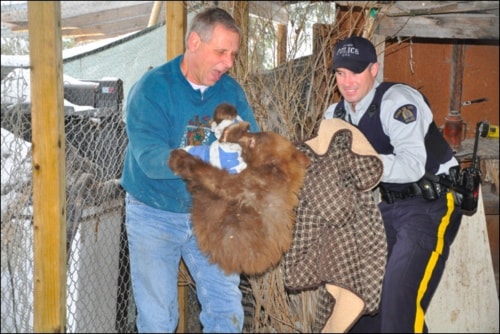Tinsel – an orphaned bear cub estimated to be 11 months old – has put the Boundary on the map. Since Christmas, the story of her rescue has gone around the world.
Tinsel was found taking shelter in Dale Tiffenbach’s chicken coop beside Boundary Creek halfway between Midway and Greenwood the week before Christmas. During church on Dec. 22 Tiffenbach told others about the starving cub.
He’d contacted both the Conservation Service and the RCMP but what to do about the bear cub was up in the air. One option being considered was putting the bear down.
But Midway resident Miranda Charles, who attends the same church, didn’t like that idea so, with Tiffenbach’s permission, she, her husband James and her father Daryll Davies (conveniently visiting from Cape Breton) went to see the cub. Both her husband and father are RCMP officers, which came in handy.
After the visit Miranda told James, “You have to do something. This poor little bear cub is just sitting in the chicken coop with the chickens running around it - not hurting them, not killing them or anything.”
When her husband called the Conservation Service he was told their options were limited that day. “The officer that he spoke to just said destroying it was most likely the best,” Miranda told the Times in an interview a week later.
But she wouldn’t take that as the answer without looking for other options. She told her husband to give her a day to make some phone calls and see what she could do.
She found the Northern Lights Wildlife Society in Smithers that had room for the cub.
Unfortunately Northern Lights doesn’t accept cubs without a conservation officer’s approval.
“But the CO that we were dealing with at that time didn’t give us that,” said Miranda. Constable Charles called the conservation office in Castlegar and reached a conservation officer there who, after talking to the shelter in Smithers, gave the approval - if the bear became trapped it could be transported to the shelter for rehabilitation.
Miranda, herself a border officer with Canada Border Services, gave the cub it’s name. Since government projects seem to always be identified with a codename, and since it was Christmas – this became known as Project Tinsel.
Meanwhile the cub was still back at the chicken coop – by now having spent at least six days there. Tiffenbach had upped the ration of feed he was putting out for the chickens and was locking the hens away at night.
But the conservation officer who approved couldn’t lawfully allow and encourage citizens to go into the coop and trap the cub. However RCMP officers could, and since Miranda’s husband and her father are both RCMP officers you can guess who got volunteered to trap the cub.
They enticed Tinsel out with pepperoni sticks. “My dad grabbed the bear and they put him in our dog kennel in the back of the truck and then dad drove to Kamloops on Tinsel’s first leg of her trip to Smithers.”
Northern Lights has an agreement with Bandstra Transportation, a trucking company that transports wildlife in distress for them.
Daryll was told if he got the bear to Kamloops that night Bandstra would take it the rest of the way. Tinsel arrived at Northern lights on Christmas Eve.
In the spring in June or July, if all goes well, she will come back down here to be released.
“It wasn’t an option to shoot it,” said Miranda. “We wanted her to have a fighting chance.”
Angelika Langen, who with her husband, operates Northern Lights reported this Monday that Tinsel is doing awesome. They didn’t know the sex until they got her sedated for a complete checkup – Tinsel is a female.
Langen says Tinsel has no real health concerns – aside from the lack of nourishment. “It will take time but she should make a full recovery,” assured Langen. “All is well. All she needs now is some good food and time to grow and by the time summer comes around she should be caught up to the other cubs that are hibernating.”
Northern Lights has ten bear cubs this winter – a smaller number than the average of 20 they look after each year. Langen said they had 32 last year; their all-time high was 45 a couple of years ago.
Langen said the first cubs they took in this year was a set of triplets. “Somebody walked out of the house in Kamloops and saw a mother bear in his fruit tree. He didn’t like it and shot her and then we had three orphans.”
She says most cubs come to the shelter as a result of human intervention – car accidents or their mothers get shot. “That’s how we end up with the cubs that are left behind.” Langen says it would help a lot if people would be more cautious with bear attractants. “Bears only come if there is an attraction. We always tell people if you go out on your front lawn and you spread around a lot of hundred dollar bills you are going to have a lot of nuisance neighbors. It’s no different if you leave a lot of high quality food out when bears are trying to fatten up for the winter. All they are after is food and if you take away the food source then the bear moves on.”
Northern Lights has been in operation for 24 years and is licensed by the government. “We look after all mammals - moose, deer and whatever else comes in.”
“We keep them until they would naturally disperse from their mother which is at about 16 to 18 months.”
When Tinsel arrived at the shelter she weighed only 9.5 kg (21 lbs.) when she should have been 25 to 34 kg (55 to 75 lbs.). The plan is to release Tinsel back into the Boundary later this spring.
